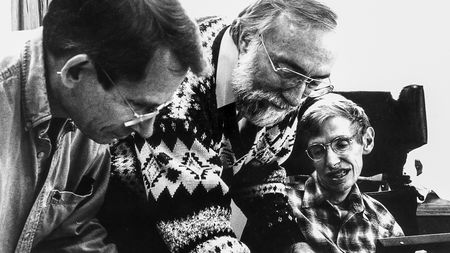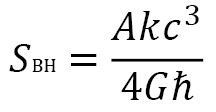Obituary: Stephen Hawking (1942-2018)

John Preskill, Kip Thorne, Stephen Hawking
The word battle used in connection with any ailment is an odd euphemism, but particularly so in the incurable and progressive. There is no battling ALS; one by one it robs the you of your motor functions and, as yet, there is nothing we can do about it. There is no dignity won by naked lies; don’t condescend to the afflicted, certainly not to the giants amongst them. You embarrass only yourself. To suffer and endure to the very last muscle is heroic enough.
Public appearances by the late Stephen Hawking were always protracted affairs. As the professor composed a sentence on his monitor, at first with hand-clicker, but then, after losing what mobility he had in his arms, by a sensor attached to his glasses and activated by moving his cheek muscle, a silence would be maintained in the invariably packed auditorium. Was this the courtesy afforded to an invalid, or reverence awaiting further pronouncement? Either way, this ambiguity certainly accommodates our culture’s appetite for figures of barely accessible genius. Of course, he was a man; let those who remember him as an esteemed colleague, imposing professor, dear friend, father, and husband remember his wit, determination, kindness, what have you: it’s not really for the rest of us. Science has a pantheon of its own.
“Only by a rapid whirling on his heel could he hope to comprehend the panorama in the sublimity of its oneness.”
– Edgar Allen Poe, Eureka
Apotheotic language, but an obituary is no occasion to humanise an icon: the man died last March, it doesn’t get much more human than that. The contrarian impulse is to – however courteously – deflate slightly the fervour and add a hearty dose of perspective to proceedings. Was his status in popular culture proportional to his contribution to science? The romantic retorts that it doesn’t matter; the Hawking we mourn is cultural shorthand for the life cerebral, whose motor neurone disease and bleak prognosis when he was a postgraduate at Cambridge plays as atrophy of the mortal bonds. His popular science books adorn millions of bookcases complete with yet pristine spines (more than can be said for the author’s), whose cautions about the potential dangers of extra-terrestrial civilisations, climate change, and AI are lent an eerie weight by the synthetic voice with which they are pronounced (DECtalk dtc01 Perfect Paul). Of course, name recognition is not divided up in proportion to accomplishment. There is a decent case to be made that Stephen Hawking was the most important physicist of the last half century, but the scientific laity doesn’t revere his colleagues and co-authors in order of contributions made, and that’s no great shame: it’d be exhausting if we did; it just indicates that we need only a few figures to fill the role.
Fool’s Errand
Sobriety here is a fool’s errand but we can at least make a stolid attempt to avoid hagiography and focus on his place in cosmology rather than in the cosmos. Please note that an obituary, even more so than scientific theory, cannot be exhaustively descriptive.
Theoretical physicists like evidence, but they don’t have the patience of Nobel committee members. Their work stands on its parsimoniousness and consistency with the established theory and existing evidence: as long as it makes sense they’ll run with it. Professor Hawking is associated with the triumph of the Big Bang Theory over the steady state model of the universe, and indeed his thesis pointing out flaws in the Hoyle–Narlikar Theory of Gravity – building on the work of Roger Penrose to disprove any problems arising from singularities – was considered devastating. But there had already been a marked redshift amongst cosmologists from the steady state model, especially following the discovery of cosmic microwave background radiation.
As proponents, Frank Hoyle and Jayant Narlikar had tweaked their steady state model, accounted for the low temperature of the cosmic microwave background, and proposed the existence of “C-fields” which would keep the density of the expanding universe constant. But Hawking showed it was to no avail, and instead proposed the expanding universe as a black hole in reverse (though confidence in this model wains on going back to the first 10−43 seconds of the universe, the so-called Planck Epoch).
The latest incarnation of the quasi steady state model was proposed in 1993 but still falls way outside mainstream cosmology. The discovery in 1998 that the expansion of the universe was accelerating has been just as vexing for the standard model which now incorporates dark energy and matter, just as much an ad hoc bodge job as anything the steady state proponents could come up with. This isn’t a slight, just the nature of theoretical physics. It’s the best we have got so we are running with it.
In an article published in 1983, titled The Wavefunction of the Universe, Hawking together with James Hartle proposed a model of the early universe. Just as there are no dimensions of space for the universe to expand into, nor are there dimensions of time outside the universe. The idea of a beginning makes sense only once there is a universe in which for it to occur. The inconveniently named Imaginary Time – imaginary only in the sense that it is expressed in what mathematicians call imaginary numbers, not in the sense of fanciful (or at least no less fanciful than anything else in theoretical physics that nonetheless has prediction power) – uses a method called “Wick rotation” to represent time as a plane rather than a line.
Traveling in space on this plane, you’ll come to a point where you loop back: this gives a closed yet boundaryless universe. Looking for a beginning in time would be like looking for the beginning of north at the north pole. This model was proposed to satisfy the Wheeler–DeWitt Equation and is an effort to resolve general relativity and quantum mechanics.
Precarious Waters
The opposing shores of modern physics are separated by some seriously precarious waters. On one side is the elegant well-trodden coast of general relativity, on the other are the brackish but fertile swamps of quantum field theory. Bridging the two, means traversing the maelstrom of the singularity where spacetime collapses in on itself. Classical and statistical mechanics, and even the best thought-out metaphors break down. The plunge is precarious (google “spaghettification”); the scaffolding wobbles unnervingly as if made of string, and – holy hell – do the builders bicker. Yet it already has wheelchair access.
Black holes are points of tremendous density warping spacetime such that anything too close (that is on the wrong side of the event horizon), even light, is unable to escape its gravity. For the most part they behave like any other massive objects and describing them doesn’t mean breaking out any tools more exotic than general relativity. Karl Schwarzschild somehow described the geometry of a non-rotating black hole in his solution of Einstein’s field equations in 1916. Roy Kerr did the same for rotating black holes in 1963. In 1965, Roger Penrose showed that a gravitational collapse resulting in an event horizon (as shown possible by Chandrasekhar, Oppenheim, and Volkoff) necessarily become a singularity. In 1967, Werner Israel showed that Schwarzschild’s black holes have spherical symmetry, and this was generalised to all black holes with Stephen Hawking and Brandon Carter showing that Kerr black holes were axisymmetric.
So, event horizons all centre on a singularity (except possibly the one shrouded by the Planck Epoch) and are fully described in terms of classical mechanics with no reference to information about the matter that formed or subsequently fell into them and is now inaccessible to the outside universe. This describes the problematic “no-hair theorem” first expressed by John Wheeler, that there is nothing else to a black hole, not even a single hair.
An event horizon as described by David Finkelstein is: “a perfect unidirectional membrane: causal influences can cross it in only one direction”. They seem like pure functions of general relativity, yet the universe is probably lousy with them: mercilessly taking in matter, giving back nothing, not even heat – apparently destroying it all. Either black holes violate the second law of thermodynamics or these one-way causal, unobservable systems, these quantum systems do somehow emit something, while also not emitting. This is the toe board where we find Stephen Hawking: black hole thermodynamics and quantum gravity.
In 1970, Hawking with James M Bardeen and Brandon Carter proposed the four laws of black hole mechanics, drawing an analogy with thermodynamics, and incorporating quantum mechanics. Uncertainty governs our interaction with things at the quantum scale. Models of the subatomic do not concern hard values but rather functions of probability. Following from the uncertainty principle the Casmir Effect shows that even a vacuum is a mess of spontaneously appearing pairs of virtual particles which immediately annihilate. Provided they appear and extinguish at the same rates the time average of energy in the system remains the same. Pairs of virtual particles appear near the event horizon, one may be caught in its gravitation and its antiparticle escapes; this causes the black hole to lose energy and following Einstein’s formula E=mc2 the mass of the black hole also decreases. Thus, the black hole loses mass and emits radiation.
Black Body Radiation
This is the basis of black hole thermodynamics. Jacob Bekenstein made this analogy explicit and showed Hawking’s earlier conclusion that black holes do not get smaller to be false. The quantum effect does allow black holes to emit black body radiation giving it entropy (a measure of natural tendency to disorder). The temperature of the radiation produced is inversely proportional to the area of the event horizon, and the smaller the black hole gets, the quicker it loses mass and eventually evaporates. Hawking showed the entropy to be exactly one quarter proportional to the area of the event horizon, giving us the Hawking-Bekenstein formula measuring what we refer to as Hawking radiation.

In a lecture given during a symposium in honour of his 60th Birthday, Hawking said he would like this formula, at once a testament to his fallibility and his brilliance, to be placed on his tombstone.
Black holes are compatible with the laws of thermodynamics but there remains another problem: the information paradox. Hawking radiation differs from thermal radiation in one major aspect. Thermal radiation contains information (the interaction of particles as understood in quantum theory as a wave function) of whatever went into the system. But Hawking radiation does not, as it does not relate to any matter or energy beyond the event horizon. This implies that information is destroyed in the black hole, which is impossible according to quantum mechanics. Hawking held firmly to the validity of the no-hair theorem and accepted a wager from John Preskill that information was in fact not destroyed, a bet Hawking conceded in 2004.[1] Gerard ‘t Hooft and Leonard Susskind put forward a strong proposal that the information is encoded on the surface of the black hole: the holographic principle, grounded in string theory. But this issue is unlikely to be resolved while our understanding of gravity jars with our understanding of the other fundamental forces.
There are four fundamental forces: the nuclear strong force, nuclear weak, electromagnetic and gravity. The first three are far stronger, are each associated with a sub atomic particle whose interactions are modelled probabilistically as quantum fields. An analogous mediating particle has not been found for gravity which is understood to be a consequence of the curvature in spacetime; there is no quantum field model for gravity and therefore no unified theory. This elusive goal is commonly referred to by the awkwardly profound term “Theory of Everything”, and harmonising gravity with quantum mechanics defined the rest of Hawking’s career, indeed that of most theoretical physicists. Hawking had his money on string theory, but we already know that doesn’t count for much.
The first observation of a black hole has been just around the corner for a while now; the likely candidate, Sagittarius A, is the one at the centre of our galaxy. Until then, the best we can manage is to detect where a black hole ought to be. A point in empty space – apparently being orbited by stars – is the probable location of a supermassive black hole. Another way of detecting a black hole is via the accretion disk: superheated matter circling the event horizon and observable as x-rays.
Sound Perturbations
In 2014, the South Pole Telescope – studying the cosmic microwave background – detected polarisation matching predictions of gravitational waves driving inflation in the early universe that were made by Alan Guth and Andrei Linde, who were working from Hawking and Hartle’s model of the early universe. The next year, gravitational waves were for the first time observed emanating from the merger of two black holes. Hawking radiation is too faint against the cosmic background to be detected. In an experiment in 2014 Jeff Steinhauer observed sound perturbations emitting from a sonic black hole, a superfluid flowing at the speed of sound, somewhat analogous to Hawking radiation.
This lack of experimental or otherwise observed hard evidence meant that Stephen Hawking did not meet all the criteria of the Nobel Prize, and now – as they are not awarded posthumously – never will. This specific lack of recognition does not detract from his standing in cosmology. Hawking did receive the Wolf Prize in Physics in 1988, the next prestigious award in the field which has gained a reputation for identifying future winners of the Nobel Prize.
Hawking was made a fellow of the Royal Society in 1974, one of the youngest scientists to receive that honour. In 1979, he was appointed to the Lucasian Chair of Mathematics at Cambridge. The chair once occupied by Isaac Newton though it wasn’t motorised[2] in his day. He was awarded a CBE in the 1982 New Year Honours, made a Companion of Honour in 1989 (though in the 1990s he turned down a knighthood), and received the Presidential Medal of Freedom in 2009.
Besides A Brief History of Time, Hawking also authored and co-authored eleven popular science books as well as six children’s books together with daughter Lucy Hawking.
A funeral ceremony was held in Cambridge on the March 31; his ashes will be interred in Westminster Abbey in a ceremony to be held on Friday, June 15.
There would appear to be an agreement that Stephen Hawking belongs alongside Newton, in the fundaments of Westminster Abbey at least. Consider again that formula he wished for his epitaph. Annoyingly, Hawking’s solution to the formula given by Jakob Bekenstein provides an exact proportion of area to entropy as of one quarter, so the formula can be simplified to S=A/4, and of course all the symbols given hide pages and pages of workings out[3] – but for our purposes this will do.
“A” denotes the area of the event horizon. “G” is the gravitational constant which though fundamental to Newton’s classical mechanics was first measured by Henry Cavendish 71 years after Newton’s death (and to this day its value is still contentious). The “k” is the Boltzmann constant, after Ludwig Boltzmann[4] and defines the relation between temperature and the kinetic energy, (statistical mechanics and thermodynamics). The symbol “c” is the speed of light in a vacuum; according to Einstein’s special relativity the maximum speed at which all conventional matter and hence all known forms of information in the universe can travel. “ℏ” (h-bar) is the reduced Planck’s constant which gives the ratio of the energy and angular momentum (it’s spin) of the quantum. “S” again is entropy as defined by Rudolf Clausius in his “second fundamental theorem in the mechanical theory of heat” (later referred to as thermodynamics). The “BH” stands for Black Hole.[5]
A physics equation, it would appear, is a painstakingly composed and brusque piece of verse, some of the greatest minds of each generation contributing but a single character – with their colleagues through the centuries editing and agonising over the precise composition. The supersession of a life’s work being not only likely but the point of the whole enterprise. Yet this verse reveals something fundamental about the workings of the universe.
Stephen Hawking 8 January 1942 – 14 March 2018 is survived by his three children Robert, Lucy, and Timothy Hawking.
About the Author

Author: John Marinus
John Marinus is a freelance writer based in the Netherlands.
Footnotes
[1] Hawking was a bookie’s delight. Besides the wager with Preskill, Hawking bet colleague Kip Thorne in 1975 that Cygnus X-1 would turn out not to be a black hole. The forfeit was a subscription to a magazine of choice. Thorne choose Penthouse. He struck again with a $100 bet made with Gordon Kane that the Higgs boson would never be found. Of course, it was, and it only took digging up a sizable chunk of the Swiss countryside. Hawking did get fourth time lucky at least: betting Neil Turok that primordial gravitational waves would be detected, resulting in the confirmation of inflationary big-bang theory.
[2] This terrible joke appears in at least two of Hawking’s books. Incidentally, Hawking appeared as himself in the opening of the final episode of Star Trek: The Next Generation in which he wins a hand of poker playing against Isaac Newton, Albert Einstein, and the android Commander Data – who will be appointed to the Lucasian Chair sometime in the 24th century.
[3] The area of a sphere for example is 4π r^2. Although – come to think of it – that would only describe non-rotating black holes. This stuff is more complicated than it looks.
[4] There is precedent for equations as epitaphs. Visit Zentralfriedhof in Vienna and above a bust of Ludwig you’ll find S = k log W Boltzmann’s entropy formula. Except this expression was given by Max Planck. In his 1920 Nobel Prize lecture Planck said: “This constant is often referred to as Boltzmann’s constant, although, to my knowledge, Boltzmann himself never introduced it – a peculiar state of affairs, which can be explained by the fact that Boltzmann, as appears from his occasional utterances, never gave thought to the possibility of carrying out an exact measurement of the constant.”
[5] Or so it would seem. The author assumes the BH stood for Bekenstein and Hawking and still thinks that is the case.
You may have an interest in also reading…
Fidel Castro: An Antagonist Remembered
The last Marxist-Leninist to hold a place on the world stage has left, signalling the end to an era that
Obituary – Wilbur Addison Smith (1933-2021): Lion of African Literature
A charming chauvinist, addicted to adventure, and in his personal life often as ruthless as the characters depicted in his
Eduardo Galeano: Remembering a Forgotten Continent
In the last days of his presidency, José Mujica visited the Casmu Hospital in Montevideo to pay his respects to

















































































